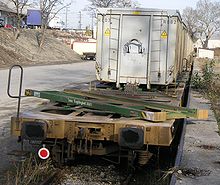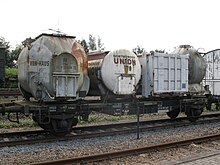Roll-off container transport system
The roll-off container transport system (ACTS) plays an important role in combined road-rail transport.
The ACTS combines the roll-off container transport that is common on the road with rail transport. The easy-to-use system enables roll-off containers to be handled quickly between trucks and trains and does not require any stationary loading aids ( forklifts , cranes ). Loads with a maximum permissible total mass of up to 17.8 t can be moved with it.
description
The roll-off container is a loading container on castors whose subframe is standardized . Its structure can be very different depending on the intended use (within the standard dimensions). The ACTS containers are available in open or covered designs, with wing doors or with RID- tested, tight flaps, as well as press containers, construction waste containers, etc.
For the road transport of the roll-off container, a truck with a rail-tested hook structure is required (also called "roll-off"), which allows loading, unloading and reloading. The railway companies provide the ACTS freight cars with rotating frames. Swiveling guide rails on the trolley allow easy reloading of the ACTS container.
Such containers are often used as waste collection containers, for example for waste glass , waste paper , construction waste and industrial waste . These containers are set up directly at the waste supplier, technically waste producer, and replaced if necessary. In the case of waste paper containers, there are also those that are connected to a press , so that the container can still hold more waste with a significantly higher empty weight.
precursor
The first intermodal loading containers were used in the Netherlands from 1934. These “load boxes” had the dimensions 2.5 m × 2 m × 2 m and were specified for a weight of up to 3000 kg. The loading from the railway car was done with a winch.
After the Second World War, these loading containers also went to Switzerland. In March 1951 an international conference was held there in Zurich-Tiefenbrunn to initiate standardization. By the Museum of Transport Switzerland and the Bureau International des Containers (BIC) different solutions of representatives from Belgium, France, the Netherlands, Germany, Switzerland, Sweden, Great Britain, Italy and the United States was able to be evaluated. The result was the UIC 590 standard of the European railway companies, also known as the Pa container ( porteur-aménagé container ). These were then used by Denmark, Benelux, West Germany, Switzerland and Sweden, for which there were adapted container wagons (BT). In Germany it was marketed under the haus zu haus brand as a large container transport system that included various types of transport attachments.
With the increasing popularity of ISO containers (first in 1966 in Europe), the Pa containers fell out of use in the 1970s (no new production after 1975, scrapped in the 2000s). Rubbish containers were increasingly being transported alone on the road. The house-to-house type Eoskrt was previously used as an open central container for garbage transport. This drove on four rollers in comparatively narrow guides on the flat car. These first roll containers use steel wheels with a diameter of 200 mm and a width of 75 mm. The transverse track width was 1400 mm and the longitudinal wheelbase was 1950 mm. Lashing eyes are attached to the wheel arches for moving and fastening.
Standardization in Germany
Roll-off containers are standardized in DIN 30722 by the Communal Technology Standards Committee (NKT). The first parts are organized according to different weight classes (part 1 to 26 t, part 2 to 32 t, part 3 to 16 t), they were first published in April 1993 and revised in the current edition from February 2007. Part 4 dealt with intermodal transport by road and rail, which has since been withdrawn without replacement. For transport by rail wagons, the roll-off containers must also comply with UIC leaflet 591.
Roll-off containers have a hook pointing upwards at 45 ° with a cross brace at a height of 1570 mm. The Road Traffic Licensing Regulations (StVZO) limit the width of the roll-off container to 2.55 m and the total height of the road vehicle including the roll-off container to 4.00 m, see also commercial vehicle / dimensions and weights . A maximum width of 2600 mm is prescribed for transport on railroad cars. The clear container length of the DIN roll-off container follows a 250 mm grid from 4000 mm to 7000 mm. In order to ensure compatibility with the standardized rotating frame for railway wagons, the length of the roll-off container suitable for rail transport is limited to a maximum of 5950 mm compared to the container suitable for road transport. The rollers according to DIN 30722 have an inner distance of 1560 and an outer distance of 2160 mm. In addition to rollers in accordance with DIN 30722, the roll-off containers must also be equipped with rail rollers, which facilitate loading onto the railway carriage rotating frame.
See also
- Swap body vehicle
- Roll-off container (hazard prevention)
- Swap body
- Swap body system Multi for the Bundeswehr. Additional container equipment (CEA) to accommodate 20-foot ISO containers is also provided here.
Web links
Individual evidence
- ↑ The Eooskrt type is slightly higher than the Eoskrt
- ↑ a b Krzysztof Lewandowski: Organizational requirements use the acts system . In: Pojazdy Szynowe . Vol. 2, 2014, ISSN 0138-0370 (English, researchgate.net [PDF; accessed on March 27, 2019] Polish: Wymagania Organizacyjne Stosowania Systemu Acts .).
- ^ Rail freight transport in the film from house to house on YouTube , accessed on March 27, 2019.
- ↑ pa-container - medium-sized containers and their transport: basic principles for pa-containers . Crap-4. S. May 6, 2013.
- ↑ Publication of DIN 30722-1, DIN 30722-2 and DIN 30722-3 . February 1, 2007. Archived from the original on April 14, 2014. Retrieved January 11, 2020.
- ↑ a b c UIC (Ed.): Transport containers for horizontal handling - Technical conditions for use in international rail traffic . 3rd edition edition. No. 591 , October 2007.
- ↑ DIN standards committee for municipal technology (publisher): DIN 30722-1: Roll-off tipper vehicles, roll-off containers - Part 1: Roll-off tipper vehicles up to 26 t, roll-off container system 1570 made of steel . December 2015.


